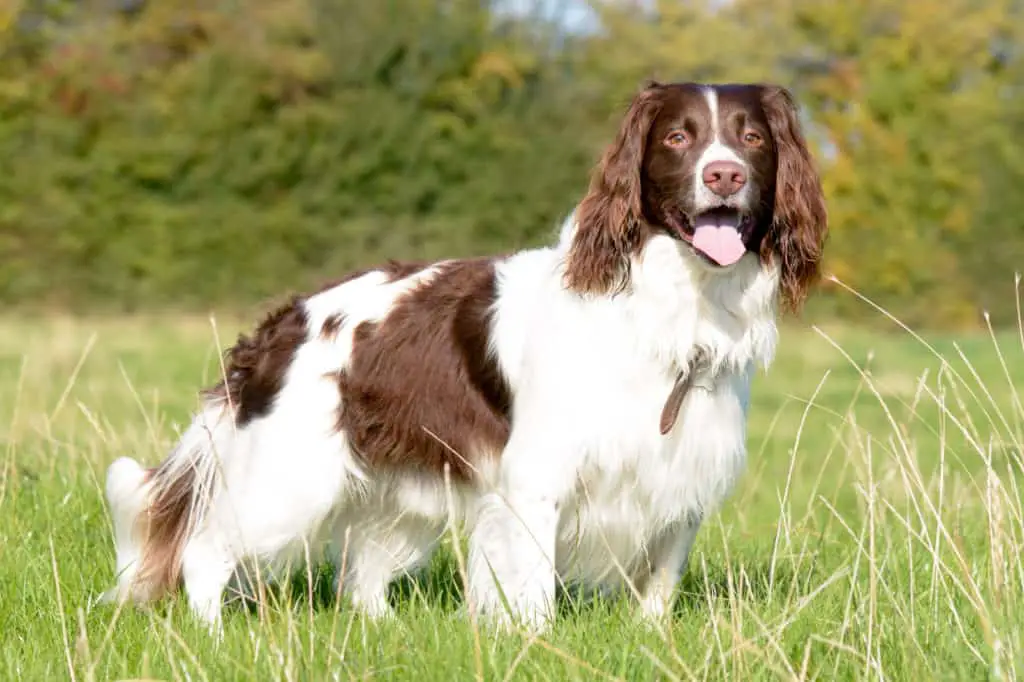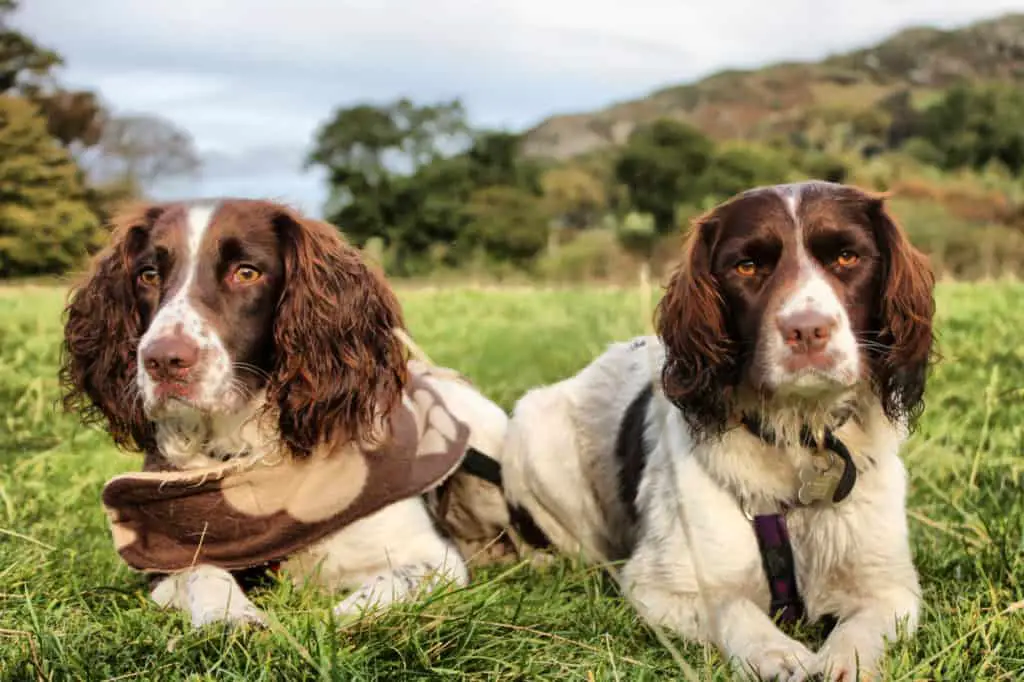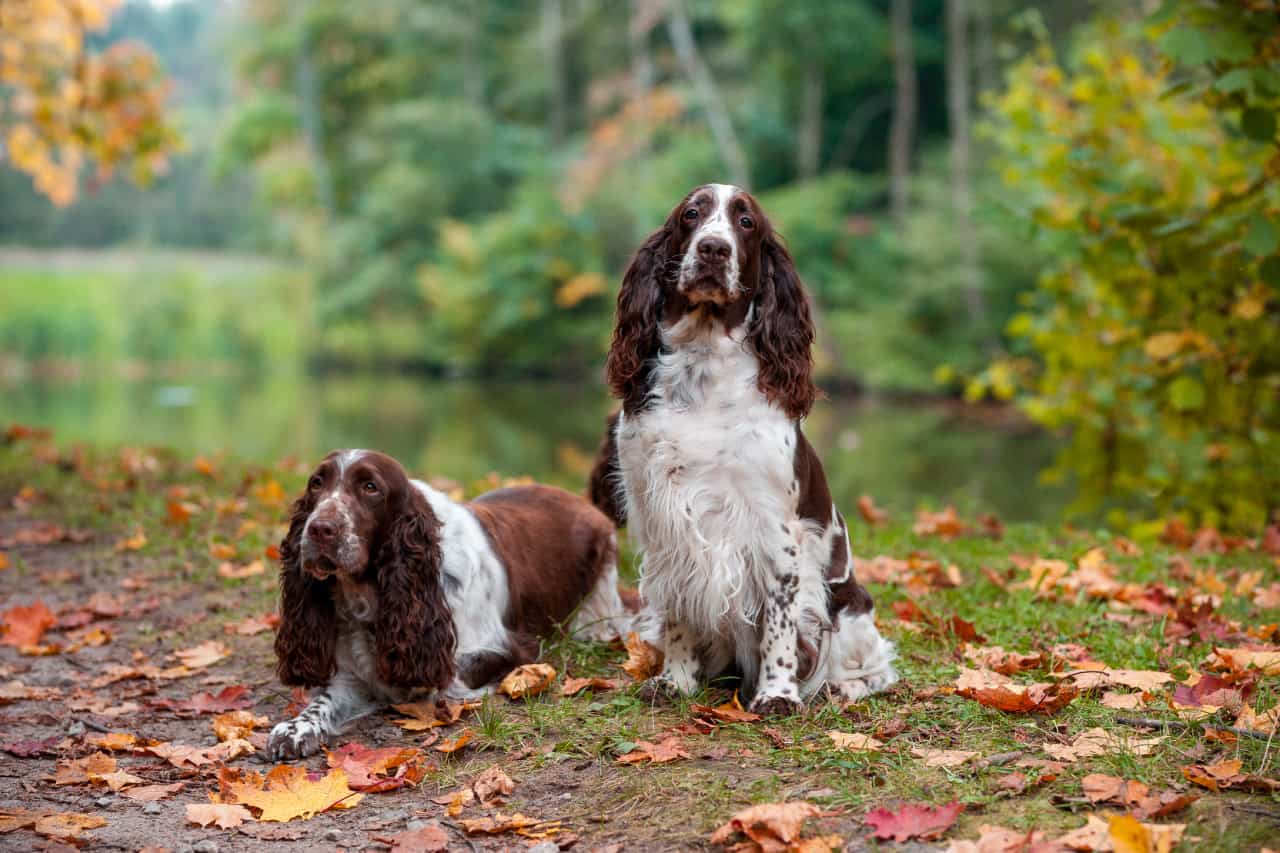English springer spaniels are beautiful, charming dogs with energetic and cheerful natures that make them excellent companions. They are friendly and devoted to their owners. Many owners report the companionship of their springers counteract stress and life pressure. English springer spaniels have ample energy and will run and hike with their owners tirelessly. When considering a dog, many people are concerned about how much the dog sheds.
English springer spaniels shed a moderate amount throughout the year. On a shedding scale of one to five, English springer spaniels score a three. Periods of heavier shedding occur in spring and fall. They have a double-layer coat that requires frequent grooming.
This article will look at what kind of coat English springer spaniels have, how much they shed, and the best ways of managing shedding. It will also look at conditions that increase shedding. The information will help you decide if you can provide the grooming necessary to manage an English springer spaniel’s coat.
English Springer Spaniels’ Coats
English springer spaniels have a double coat. There is a soft undercoat that is dense, and woolly. This coat helps to insulate the dog and retain body heat. The undercoat is thicker during winter than in summer. The topcoat consists of longer, coarser hair which may be wavy or straight. English springer spaniels are known for their beautiful feathering. Feathering is a fringe of hair that grows longer on the back of the legs, on the dog’s underside, and the ears.
The topcoat functions as a waterproof layer in the English springer spaniel’s coat. In addition, it protects the soft undercoat from burrs and debris that could irritate the spaniel’s skin. Burrs are less likely to stick to the coarser hairs of the topcoat.
Is There A Difference Between Show And Field English Springer Spaniels?
English springer show spaniels have a much longer, luxurious coat than field spaniels. The feathering on show spaniels is extensive, and the ears are longer and more heavily feathered. They are designed to be shown and not to work in the field. The show spaniel’s coat would be problematic for a dog working in dense undergrowth. Working English springer spaniels have shorter ears and a shorter coat. There is less feathering on the legs, ears, and belly. Working springer spaniels have been bred to have practical coats for working in heavily wooded fields and undergrowth.
Do Springer Spaniels Shed A Lot?
English springer spaniels shed a moderate amount. They score a three on a shedding scale of one to five. They have a heavier period of shedding in spring and fall. Groomers refer to the heavy shedding period as ‘blowing their coats.’ This phenomenon usually lasts for two to four weeks. The spring shedding occurs because the springer spaniel needs to get rid of the heavy winter coat as the summer temperature increases. The coat shedding in fall occurs so that a thicker coat can be grown again for the winter cold. Puppies will not shed as much as adults.
Comparing Shedding In Spaniels
| Type of Spaniel | Shedding Score out of 5 |
| English springer spaniel | 3 |
| Welsh springer spaniel | 3 |
| Cocker spaniel | 3 |
| American water spaniel | 2 |
| Irish water spaniel | 1 – minimal shedding |
| Boykin Spaniel | 3 |
Is It Possible To Stop An English Springer Spaniel From Shedding?
It is not possible to stop an English springer spaniel from shedding. Coat shedding is a natural phenomenon that allows the dog to cope with changing temperatures in different seasons. It is also a means of getting rid of old hairs so that the coat stays healthy. You can put a program in place to reduce the impact of English springer spaniel shedding. This includes grooming, bathing, and feeding the dog a well-balanced diet.
Grooming An English Springer Spaniel
English springer spaniels need to be brushed two or three times a week. It is essential to start training your dog to tolerate grooming from when you get it as a young puppy. It makes your life a lot more challenging to groom your adult dog when you are involved in wrestling him to stand or lie still.
When grooming a young puppy, start with a soft brush that will not pull hard on the pup’s sensitive skin. Use frequent treats and praise to reward your puppy as you groom. Everything about the experience should be designed to create a positive experience so that the spaniel comes to love grooming. Keep the sessions short as a puppy as a limited attention span. A maximum of ten minutes of grooming should be done at any one time with a puppy.
What Brushes And Tools Should You Use To Groom An English Springer Spaniel?
A slicker brush is an essential tool to detangle the topcoat and eliminate burrs and debris stuck in the coat. Many slicker brushes come with retractable bristles, which is helpful to remove hair from the bristles. Start at the springer spaniel’s head and work down the body towards the tail.
An undercoat dematting and grooming rake cuts through mats, pulling out all the loose hair that has clumped together. It is much less painful for the dog if you use one of these tools. A straight comb will hook in matts and pull on the skin, causing pain for the dog. Always hold the hair close to the skin while using the rake with your other hand. This method helps to lessen painful pulling.

Why Is Brushing An English Springer Spaniel Helpful?
Brushing an English springer spaniel removes loose hair that would otherwise land up on your furniture or clothes. The bristles on the brush massage the skin helping to distribute the natural oils on the skin. These factors promote a healthy coat which results in less shedding.
What Is Hand-Stripping?
Hand stripping is a method of removing the undercoat. Using your fingers, gently tug on the undercoat and pull out loose pieces. The loose hair generally comes out in chunks. It must be done gently, and sometimes it is possible to see the loose hair in the undercoat, which makes the job easier. Some owners and groomers swear by this method. It results in a natural looking coat without any unevenness.
Bathing Helps Reduce Shedding
Bathing your English springer spaniel helps reduce shedding as it loosens old hair. Always use a good quality pet shampoo that does not irritate the dog’s skin. The shampoo should be massaged in well as this helps to loosen hair about to fall out. Rinsing very well is essential. Any shampoo left on the spaniel will irritate the skin and increase shedding.
Do not bathe your springer spaniel too often. This will strip the skin of its natural oils and cause the skin condition to deteriorate. Bathing every two to three weeks is acceptable, but some owners prefer to bathe their spaniel only once a month. After bathing, brushing your spaniel will remove a lot of hair and so it particularly useful during the heavy spring and fall shedding periods.
Should My Springer Spaniel Be Shaved?
English springer spaniels should not be shaved. Shaving exposes the spaniel’s skin to the elements. A skin adapted to a double coat cannot cope with sudden exposure to wind and sun. The skin becomes irritated and itchy, which causes further shedding. Double coated dogs should never be shaved as it interferes with the dog’s ability to keep cool. In summer, the undercoat becomes very thin, allowing air to circulate under the topcoat. The topcoat protects the dog from the sun.
The undercoat grows much faster than the topcoat, and burrs and seeds will get stuck in the undercoat that is now exposed as the hair grows back. Dogs with double coats that are shaved often struggle with hot spots. Hot spots are a painful form of weeping or moist dermatitis. An open oozing sore develops on the dog that is extremely itchy and painful. All the hair in that area falls out.
Diet and Shedding In English Springer Spaniels
Diet plays a critical role in skin health and, therefore, coat health. A well-balanced diet is necessary to keep the skin pliable, moisturized, and resistant to infection. Nutritional deficiencies can cause lesions, skin irritations, or dry skin, which is very itchy. All of this will increase shedding.
A diet rich in omega oils, vitamin E, and vitamin B will assist with skin and coat integrity. Dogs with dietary allergies usually have skin irritation and poor coat quality. It is essential to find a diet that meets your spaniel’s nutritional needs without triggering allergies.
The Diet Must Be Balanced
Hair consists mainly of protein. Your English springer spaniel’s diet must consist of the correct amount of digestible protein. Fat content is vital to maintain healthy skin. Meats such as chicken have low fat content, so a chicken-based diet will need additional fats added to the diet.
The best fat for dogs is animal fat, as this is the most easily absorbed. Vegetable fats can be added, but they are not utilized efficiently in the spaniel’s digestive system. A general rule is that adult springer spaniels need twenty-five to thirty percent protein and ten to fifteen percent fats in their food. Puppies need thirty to thirty-five percent protein and fifteen to thirty percent fats.
The age of the dog and the size of the dog will determine the dietary requirements. A puppy will have a higher need for protein and fats than an older dog as they are needed for growth. Similarly, a large breed puppy has different dietary needs than a toy breed puppy. Starting your English springer spaniel puppy off with the correct diet will result in a dog with a healthy coat and skin.
Essential Minerals For Skin And Coat Health
Zinc is an essential mineral for skin and coat health. Lack of zinc causes the hair to fall out, the skin to ulcerate and thicken in some areas. Copper deficiency results in a coat that is dull, dry, and patchy with pigment loss. Too many minerals can be as problematic as too few minerals. Both can cause shedding to increase.
Essential Fatty Acids
Essential fatty acids are important ingredients in an English springer spaniel’s diet as dogs cannot manufacture them. Lack of essential fatty acids leads to dry, scaly skin and hair that has lost its elasticity and matts easily. The hair falls out continuously.

Conditions That Increase Shedding
Several health conditions can increase shedding in the English springer spaniel. These may be brought about by metabolic dysfunction, bacterial or fungal infections, parasites, and immune system issues.
Allergy
As mentioned previously, dietary allergies can seriously impact skin and coat health, increasing shedding. Allergies can also be environmental. These are particularly difficult to deal with as it may be impossible to eliminate the allergen. Environmental allergens include grass, pollen, and dust mites. A flea infestation can cause severe dermatitis and increase shedding to the point that the spaniel looks almost bald. It is crucial to maintain flea prevention protocols.
Parasites
Parasites such as demodectic and sarcoptic mange cause thickening of the skin and severe hair loss. Mange is a serious condition that needs veterinary attention. The treatment continues over several months in some cases.
Skin Cancers
Skin cancers are more common in dogs with a primarily white coat. English springer spaniels from field lines often have a predominantly white coat with colored markings making them more prone to skin cancer. Skin cancer causes suppurating lesions that are prone to secondary bacterial infections. This causes hair loss in the area of the tumor.
Seborrhea
Seborrhea comes in two forms: dry seborrhea and oily seborrhea. Most dogs with seborrhea have both dry and oily seborrhea in different parts of the body. Seborrhea is a malfunction of the sebum glands. It is prominent on the dog’s back, flanks, and face. The skin becomes inflamed, and raw lesions may appear, or there may be dry, flaky skin resembling dandruff. Both kinds cause hair loss.
Seborrhea has a range of causes. It may have its basis in hormonal imbalances, dietary deficiencies, fungal infections (especially yeast), parasites, obesity, allergies, and musculoskeletal diseases. It needs detailed testing and veterinary intervention to manage.
Lupus
Lupus is an immune-mediated disease that affects the connective tissue, including the skin. In advanced stages, it causes severe hair loss. Lupus affects multiple body systems and organs, even causing seizures. There is no cure for lupus, and it requires close consultation with an experienced, often specialist, veterinarian to manage it.
Alopecia Areata
Alopecia areata is another immune-mediated condition that causes patchy hair loss. The hair is lost faster than the follicle can replace it. This condition is usually seen on the head, face, ears, and legs. Sometimes it may be generalized to the whole body. There can be spontaneous recovery, but persistent cases will need veterinary intervention. Fortunately, alopecia areata usually responds well to medication.
Hypothyroidism
Hypothyroidism occurs when the thyroid functions minimally. It is characterized by a dull, thin coat with extensive hair loss and scales on the skin. There is also weight gain, lethargy, and an inability to deal with cold temperatures. Veterinary intervention will focus on providing thyroid replacement hormones. Treatment is usually successful but will need to be managed for the rest of the spaniel’s life.
Managing Dog Hair In The Home
A good vacuum cleaner will assist with removing hair from floors, carpets, and furniture. There are vacuum cleaners specially designed to remove pet hair. These have handheld attachments that can be used on clothing as well. Lint removing strips or machines can help remove hair on clothing. A tumble dryer helps remove hair from clothes and bedding.
Conclusion
English springer spaniels shed moderately, but this can be managed by regular grooming, bathing, and a balanced diet. Some conditions can worsen shedding, and these should be addressed with veterinary assistance. An English springer spaniel is not the right choice for you if you are house proud or allergic to dog hair. They are, however, entertaining, comforting companions and talented hunting dogs for those who are prepared to deal with their grooming needs and some dog hair in the home.
References
https://vcahospitals.com/know-your-pet/nutrition-skin-and-dogs
https://vcahospitals.com/know-your-pet/seborrhea-in-dogs
https://vsas.org/2017/07/why-shaving-your-double-coated-dog-is-not-your-best-idea/

